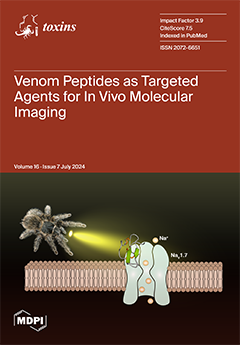Currently, the search for new alternatives to conventional antibiotics to combat bacterial resistance is an urgent task, as many microorganisms threaten human health due to increasing bacterial resistance to traditional medicines. Thus, new molecules such as antimicrobial peptides have emerged as promising alternatives
[...] Read more.
Currently, the search for new alternatives to conventional antibiotics to combat bacterial resistance is an urgent task, as many microorganisms threaten human health due to increasing bacterial resistance to traditional medicines. Thus, new molecules such as antimicrobial peptides have emerged as promising alternatives because of their low induction of resistance and broad spectrum of action. In this context, in the past few years, our research group has synthesized and characterized a peptide derived from the C-terminal region of the Lys
49 PLA
2-like BthTX-I, named p-BthTX-I. After several studies, the peptide (p-BthTX-I)
2K was proposed as the molecule with the most considerable biotechnological potential. As such, the present work aimed to evaluate whether the modifications made on the peptide (p-BthTX-I)
2K can be applied to other molecules originating from the C-terminal region of PLA
2-like Lys
49 from snake venoms. The peptides were obtained through the solid-phase peptide synthesis technique, and biochemical and functional characterization was carried out using dichroism techniques, mass spectrometry, antimicrobial activity against ESKAPE strains, hemolytic activity, and permeabilization of lipid vesicles. The antimicrobial activity of the peptides was promising, especially for the peptides (p-AppK)
2K and (p-ACL)
2K, which demonstrated activity against all strains that were tested, surpassing the model molecule (p-BthTX-I)
2K in most cases and maintaining low hemolytic activity. The modifications initially proposed for the (p-BthTX-I)
2K peptide were shown to apply to other peptides derived from Lys
49 PLA
2-like from snake venoms, showing promising results for antimicrobial activity. Future assays comparing the activity of the dimers obtained through this strategy with the monomers of these peptides should be carried out.
Full article






